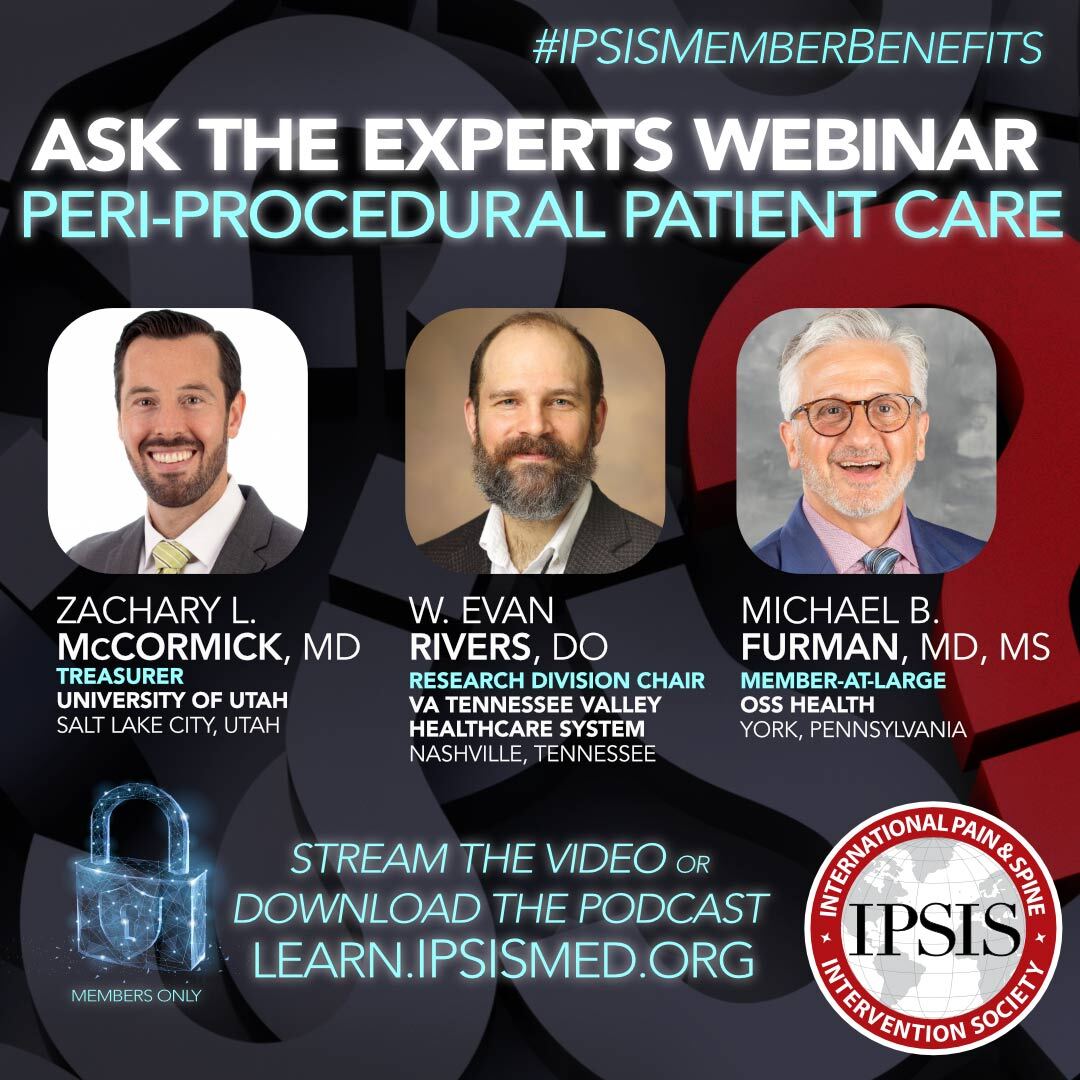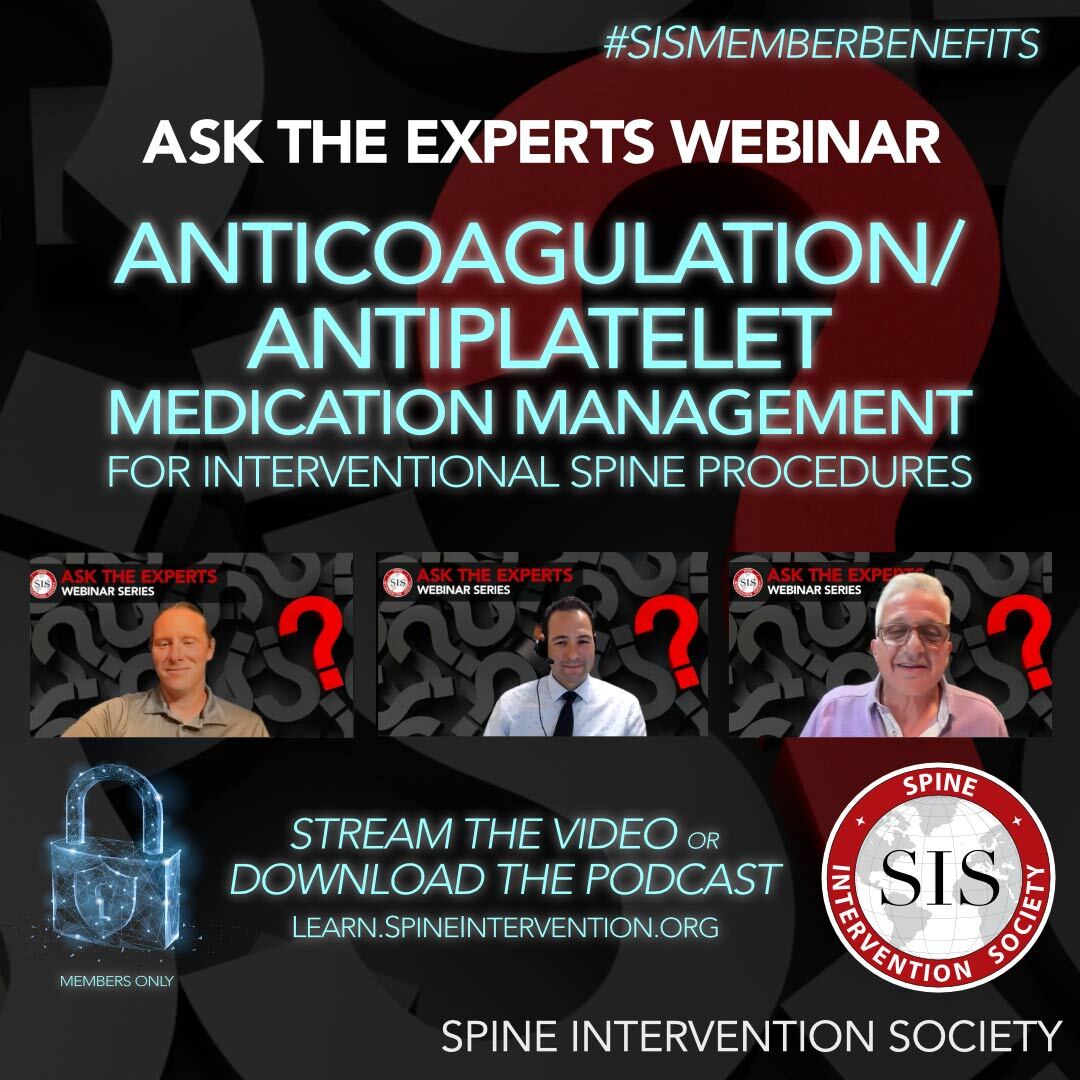
Catalog Advanced Search
-
Contains 40 Component(s), Includes Credits
On-Demand Video
The Radiofrequency (RF) Neurotomy Core Curriculum product includes all lectures presented during IPSIS Radiofrequency Bio-skills Courses. As an IPSIS member*, you can purchase this educational offering and dive into these topics:
- Anatomy, Technique, and Evidence Base
- L2-4 Medial Branch RF Neurotomy
- L5 Dorsal Ramus RF Neurotomy
- Third Occipital Nerve RF Neurotomy
- C3-6 Medial Branch RF Neurotomy
- C7 Medial Branch RF Neurotomy
- Principles of RF Denervation
- Anatomy of Cervical Posterior Column Innervation
- Anatomy of Lumbar Posterior Column Innervation
- Lumbar and Cervical Medial Branch Blocks: Response and Interpretation
- The Sacroiliac Joint: Function, Anatomy, & Innervation +
- The Sacroiliac Joint: Imaging and Clinical Assessment +
- Sacral Lateral Branch Blocks and RF +
- Risks and Complications
© 2020 and 2024 International Pain and Spine Intervention Society – All Rights Reserved
Materials presented in this activity have been made available by the International Pain and Spine Intervention Society for educational purposes only. We reserve all rights to such material.* Continual membership is expected to access the modules in your member profile.
+ New lecture added April 2024Educational Objectives
Upon completion of this activity, participants should be able to:- Analyze the imaging depiction of the relevant anatomy;
- Relate patient history and physical exam findings with imaging to achieve a likely diagnosis of the spinal pathology; causing the patient’s pain or dysfunction;
- Describe the literature support for the efficacy of the procedures;
- Identify the risks and benefits of each procedure, as well as assessment, prevention, and treatment of potential complications;
- Apply technically correct performance of the spinal procedures using safe fluoroscopic guidance with minimal tissue injury or discomfort.
Disclosure Information
Activity Reviewers: Rena Beckerly, MD; Peter Yeh, MD
None of the reviewers had any financial relationships with ACCME-defined ineligible companies to disclose.
Accreditation Statement
The International Pain & Spine Intervention Society (IPSIS) is accredited by the Accreditation Council for Continuing Medical Education to provide continuing medical education for physicians.
Credit Designation Statement
IPSIS designates this enduring material for a maximum of 6.0 AMA PRA Category 1 Credit(s)™. Physicians should claim only the credit commensurate with the extent of their participation in the activity.References
References are provided within the speakers' presentations.Commercial Support
No commercial support was received for this activity.Original Release Date: 10/21/2020
Original Disclosure Information
RELEVANT FINANCIAL RELATIONSHIPS WITH ACCME-DEFINED INELIGIBLE COMPANIES
Richard Bundschu, MD
Speakers Bureau: Nevro; Grant and research support: Nevro; StimGenics
Aaron Calodney, MD
Consultant: Stryker; Nevro; Boston Scientific; Medtronic; Saluda
Speaker: Stryker; Nevro; Boston Scientific; Medtronic; Pain Teq; Apex Biologix; Vertos
Research support: Medtronic; Nevro; Stryker; Boston ScientificNone of the other planners or speakers had relevant financial relationships with ACCME-defined ineligible companies. All relevant financial relationships have been mitigated.
Renewal Date: 04/20/2023
Expiration Date: 04/19/2026-
Register
- Member - $499
- In-Training Member - $499
- More Information
- Anatomy, Technique, and Evidence Base
-
Contains 1 Component(s)
Audio
Your expert panel covered questions on leveraging radiologic studies in spine care including:
- Which "red flag" symptoms warrant imaging?
- Other than trauma and "red flags," when else do we need imaging, and what should we get?
- When MRI isn’t an option, when is a myelogram preferred over a "dry” CT?
- Can bone scans assist in diagnosing facet-mediated and /or other types of pain?
- How are modic changes associated with low back pain?
- When are interventional pain physicians responsible for incidental findings?
- What are the latest recommendations about gadolinium?
Your expert panel for this February 8, 2024 webinar included:
- Felix E. Diehn, MD, Consultant and Associate Professor in Radiology at Mayo Clinic in Rochester, Minnesota; and
- IPSIS Secretary, Vinil Shah, MD, Associate Professor of Radiology and Chief of the Neuroradiology Division at the University of California San Francisco (UCSF).
The panel was moderated by Michael B. Furman, MD, MS, Fellowship Director at OSS Health and Chair of the IPSIS Membership Committee.
This webinar is also available as a streamable video.
-
Register
- Member - Free!
- In-Training Member - Free!
- More Information
-
Contains 2 Component(s)
On-Demand Video
In this session, our expert panel covered the topics listed below:
- Which "red flag" symptoms warrant imaging?
- Other than trauma and "red flags," when else do we need imaging, and what should we get?
- When MRI isn’t an option, when is a myelogram preferred over a "dry” CT?
- Can bone scans assist in diagnosing facet-mediated and /or other types of pain?
- How are modic changes associated with low back pain?
- When are interventional pain physicians responsible for incidental findings?
- What are the latest recommendations about gadolinium?
Your expert panel for this February 8, 2024 webinar included:
- Felix E. Diehn, MD, Consultant and Associate Professor in Radiology at Mayo Clinic in Rochester, Minnesota; and
- IPSIS Secretary, Vinil Shah, MD, Associate Professor of Radiology and Chief of the Neuroradiology Division at the University of California San Francisco (UCSF).
The panel was moderated by Michael B. Furman, MD, MS, Fellowship Director at OSS Health and Chair of the IPSIS Membership Committee.
Listen on the go — make "Ask the Experts" your new go-to podcast! Besides the video, an audio download is also available here.
-
Register
- Member - Free!
- In-Training Member - Free!
- More Information
-
Contains 1 Component(s)
Audio

Your expert panel covered topics not addressed in the prior Peri-procedural Considerations webinar, regarding pre-, intra-, and post-procedure patient care, and provided specific:
- Tactics to Help Treat Patients with Contrast Media Allergies
- Tips on Addressing Radiofrequency Neurotomy Challenges Posed by Patients with Pacemakers, Defibrillators, and Other Implanted Hardware
- Selection Strategies for Injectate Composition and Volume
- Viewpoints on Which Procedures Are Best Performed in Offices, Ambulatory Surgery Centers (ASCs), or Hospital Settings
- Information on the Features of Proper Informed Consent
Your expert panel for this December 5, 2023 webinar included:
- Zachary L. McCormick, MD, IPSIS Treasurer, and Vice Chair and Associate Professor in the Department of Physical Medicine and Rehabilitation (PM&R) at the University of Utah; and
- W. Evan Rivers, DO, IPSIS Research Division Chair and a physiatrist at the VA Tennessee Valley Healthcare System.
The panel was moderated by Michael B. Furman, MD, MS, Fellowship Director at OSS Health and Chair of the IPSIS Membership Committee.
This webinar is also available as a streamable video.
-
Register
- Member - Free!
- In-Training Member - Free!
- More Information
-
Contains 2 Component(s)
On-Demand Video

Your expert panel covered topics not addressed in the prior Peri-procedural Considerations webinar, regarding pre-, intra-, and post-procedure patient care, and provided specific:
- Tactics to Help Treat Patients with Contrast Media Allergies
- Tips on Addressing Radiofrequency Neurotomy Challenges Posed by Patients with Pacemakers, Defibrillators, and Other Implanted Hardware
- Selection Strategies for Injectate Composition and Volume
- Viewpoints on Which Procedures Are Best Performed in Offices, Ambulatory Surgery Centers (ASCs), or Hospital Settings
- Information on the Features of Proper Informed Consent
Your expert panel for this December 5, 2023 webinar included:
- Zachary L. McCormick, MD, IPSIS Treasurer, and Vice Chair and Associate Professor in the Department of Physical Medicine and Rehabilitation (PM&R) at the University of Utah; and
- W. Evan Rivers, DO, IPSIS Research Division Chair and a physiatrist at the VA Tennessee Valley Healthcare System.
The panel was moderated by Michael B. Furman, MD, MS, Fellowship Director at OSS Health and Chair of the IPSIS Membership Committee.
Listen on the go — make "Ask the Experts" your new go-to podcast! Besides the video, an audio download is also available here.
-
Register
- Member - Free!
- In-Training Member - Free!
- More Information
-
Contains 2 Component(s)
On-Demand Video
 In this session, our experts provided:|
In this session, our experts provided:|- Tactics to Navigate Medicare/Medicaid and Avoid Recoupment and Penalties
- Tips on Avoiding Peer-to-Peer Reviews — Regardless of Region
- Approaches for Medicare and Private Payer Prior Authorization
- Information on Local Coverage Determinations (LCDs) and UCR (Usual, Customary, and Reasonable) Rates
- Strategies to Document and Schedule ESIs, Facet, SIJ Interventions
- Methods to Utilize Advance Beneficiary Notices (ABNs) of Non-Coverage to Get Paid for Services Not Usually Covered by Medicare
Your expert panel for this October 23, 2023 webinar included:
- D. Scott Kreiner, MD, a physiatrist and interventional spine specialist at Barrow Neurological Institute who also serves on the IPSIS Board as a Member-at-Large; and
- Richard W. Rosenquist, MD, Chairman of the Department of Pain Management in the Anesthesiology Institute of the Cleveland Clinic.
The panel was moderated by Michael B. Furman, MD, MS, Fellowship Director at OSS Health and Chair of the IPSIS Membership Committee.
Listen on the go — make "Ask the Experts" your new go-to podcast! Besides the video, an audio download is also available here.
-
Register
- Member - Free!
- In-Training Member - Free!
- More Information
-
Contains 1 Component(s)
Audio
 In this session, our experts provided:
In this session, our experts provided:- Tactics to Navigate Medicare/Medicaid and Avoid Recoupment and Penalties
- Tips on Avoiding Peer-to-Peer Reviews — Regardless of Region
- Approaches for Medicare and Private Payer Prior Authorization
- Information on Local Coverage Determinations (LCDs) and UCR (Usual, Customary, and Reasonable) Rates
- Strategies to Document and Schedule ESIs, Facet, SIJ Interventions
- Methods to Utilize Advance Beneficiary Notices (ABNs) of Non-Coverage to Get Paid for Services Not Usually Covered by Medicare
Your expert panel for this October 23, 2023 webinar included:
- D. Scott Kreiner, MD, a physiatrist and interventional spine specialist at Barrow Neurological Institute who also serves on the IPSIS Board as a Member-at-Large; and
- Richard W. Rosenquist, MD, Chairman of the Department of Pain Management in the Anesthesiology Institute of the Cleveland Clinic.
The panel was moderated by Michael B. Furman, MD, MS, Fellowship Director at OSS Health and Chair of the IPSIS Membership Committee.
This webinar is also available as a streamable video.
-
Register
- Member - Free!
- In-Training Member - Free!
- More Information
-
Contains 1 Component(s)
Audio

In this session, our experts covered your questions on:
- What are the thrombotic implications of stopping ACAP medications?
- Which procedures can be safely performed without stopping ACAP medications?
- If stopped, are some ACAP medications more likely to result in thrombotic events?
- What are the incidence and implications of bleeding complications during procedures, and are these risks increased when ACAP medications are continued?
- Why should interventionists be more involved in ACAP medication decisions instead of reflexively deferring to the prescribing physician?
Your expert panel for this August 15, 2023 webinar included:
- Byron J. Schneider, MD, Director of the Interventional Spine and Musculoskeletal Medicine Fellowship at Vanderbilt University Medical Center, and IPSIS Research Division Chair; and
- Gene Tekmyster, DO, Assistant Professor of Clinical Orthopaedic Surgery at Keck Hospital of USC, and IPSIS Membership Committee Member.
The panel was moderated by Michael B. Furman, MD, MS, Fellowship Director at OSS Health and Chair of the IPSIS Membership Committee.
-
Register
- Member - Free!
- In-Training Member - Free!
- More Information
-
Contains 2 Component(s)
On-Demand Video
 In this session, our experts covered your questions on:
In this session, our experts covered your questions on:- What are the thrombotic implications of stopping ACAP medications?
- Which procedures can be safely performed without stopping ACAP medications?
- If stopped, are some ACAP medications more likely to result in thrombotic events?
- What are the incidence and implications of bleeding complications during procedures, and are these risks increased when ACAP medications are continued?
- Why should interventionists be more involved in ACAP medication decisions instead of reflexively deferring to the prescribing physician?
Your expert panel for this August 15, 2023 webinar included:
- Byron J. Schneider, MD, Director of the Interventional Spine and Musculoskeletal Medicine Fellowship at Vanderbilt University Medical Center, and IPSIS Research Division Chair; and
- Gene Tekmyster, DO, Assistant Professor of Clinical Orthopaedic Surgery at Keck Hospital of USC, and IPSIS Membership Committee Member.
The panel was moderated by Michael B. Furman, MD, MS, Fellowship Director at OSS Health and Chair of the IPSIS Membership Committee.
Listen on the go — make "Ask the Experts" your new go-to podcast! Besides the video, an audio download is also available here.-
Register
- Member - Free!
- In-Training Member - Free!
- More Information
-
Contains 2 Component(s)
On-Demand Video
In this session our experts covered your questions on:
- What's the Right Amount and Frequency?
- What's the Daily and Lifetime Maximum?
- Why Do Some Regenerative Medicine Physicians Consider Steroids "Poison”?
- Are Non-Particulate Steroids Really Non-Inferior?
Your expert panel for this July 18, 2023 webinar included:
- Kate Sayeed, MD, Director of Pain Medicine at the VA Texas Valley Coastal Bend Healthcare System, and IPSIS Member-at-Large; and
- Alison Stout, DO, of the Cleveland Clinic, Lerner College of Medicine, and IPSIS Treasurer.
The panel was moderated by Michael B. Furman, MD, MS, Fellowship Director at OSS Health and Chair of the IPSIS Membership Committee.
Listen on the go — make "Ask the Experts" your new go-to podcast! Besides the video, an audio download is also available here.-
Register
- Member - Free!
- In-Training Member - Free!
- More Information









